This Blackened Swordfish recipe is one of the easiest ways to cook this firm, meaty fish. Sear it in a hot cast iron skillet with Cajun seasoning, and you’ve got a restaurant-quality dinner in 15 minutes.

We’ve caught plenty of fresh swordfish here in the Florida Keys, and this is one of our go-to family recipes.
Jump to:
- Blackened Seasoning Recipe
- Blackened Spice Rub from Scratch
- Ingredients
- How to Remove the Bloodline from Fresh Swordfish
- Seasoning Swordfish Steaks
- How To Cook Swordfish on The Stove
- Cooking a Thick Swordfish Steak
- Storage and Reheating
- What To Serve With Blackened Swordfish
- More Blackened Fish Recipes
- FAQ
- Where to Cook Your Catch in Key Largo
- Blackened Swordfish Recipe
Blackened Seasoning Recipe
I have a tasty Homemade Blackened Rub that you can use to add Cajun flavor to your swordfish.
This seasoning can be used for all types of fish and shellfish. Just dust it on your fish and cook in a little oil in a skillet or hot grill.
Try it on mahi mahi, grouper, hogfish, yellowtail, mutton snapper, tripletail, and shrimp!
Years ago, I used to get Paul Prudhomme's blackening seasoning because it tastes good, and I was able to pick it up at the fish market. Try Paul Prudhomme's Magic Seasoning Blends Blackened Redfish Magic from Key Largo Fisheries or Publix if you're in a pinch!

Blackened Spice Rub from Scratch
Lately, I’ve been all about making things from scratch, including my own seasonings. This recipe makes enough to season about three pounds of fish.
I mix the spices in a Mason jar so I can use a few tablespoons at a time and save the rest. If stored in a cool, dark place, it stays fresh for up to six months.
This seasoning is also great on any kind of fish, shrimp, and chicken.

Ingredients
Whisk together the following:
- sweet Hungarian paprika
- garlic powder
- onion powder
- ground thyme
- ground oregano
- cayenne pepper
- salt
- black pepper
Quantities in recipe card below.
For the full blackened seasoning recipe, check out the full post.
How to Remove the Bloodline from Fresh Swordfish
Most swordfish steaks are sold frozen in vacuum-sealed packages that have already had the bloodline removed. If you have fresh fish, the bloodline might still be present. While it's safe to eat, it is very oily and fishy tasting and can easily be removed.
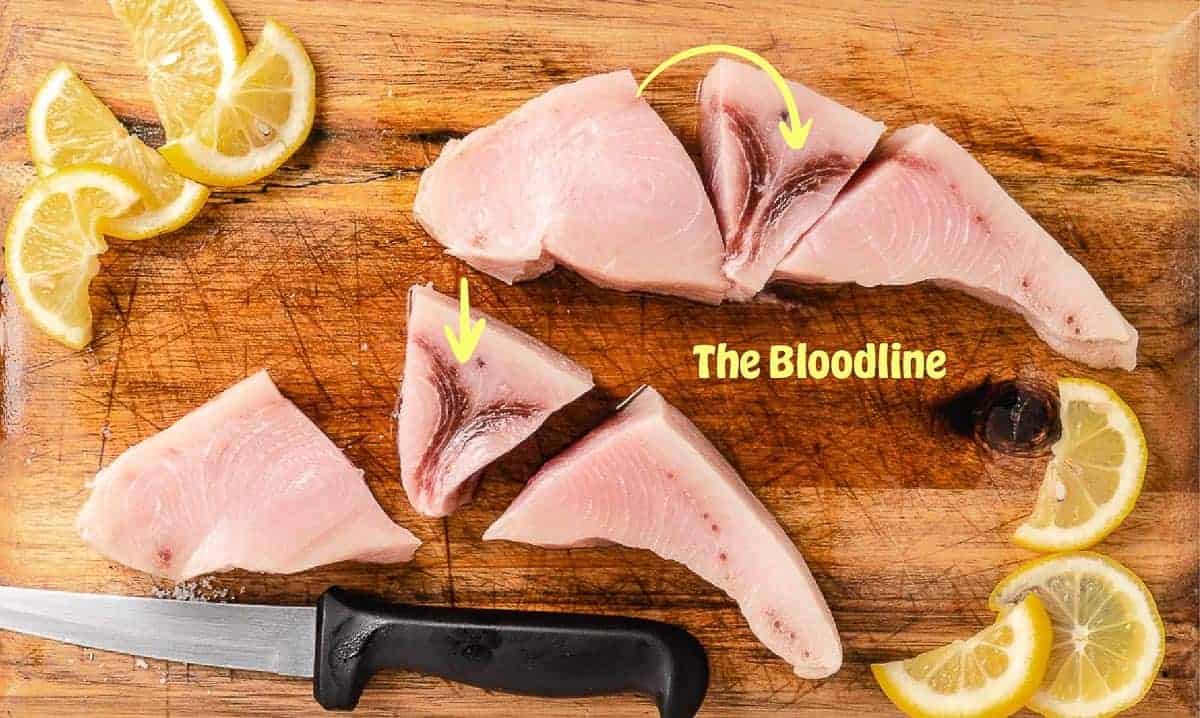
Remove the bloodline by cutting away the dark piece from the center of the steak. Two cuts are all you need. Wash the fish under cold running water and pat dry with paper towels.
Seasoning Swordfish Steaks
- On a medium-sized plate, scatter the blackening seasoning. Brush the fish with a thin coat of oil or melted butter and press one side of the fish into the seasoning.
- You can season the second side with a little salt. Repeat with the remaining fish.
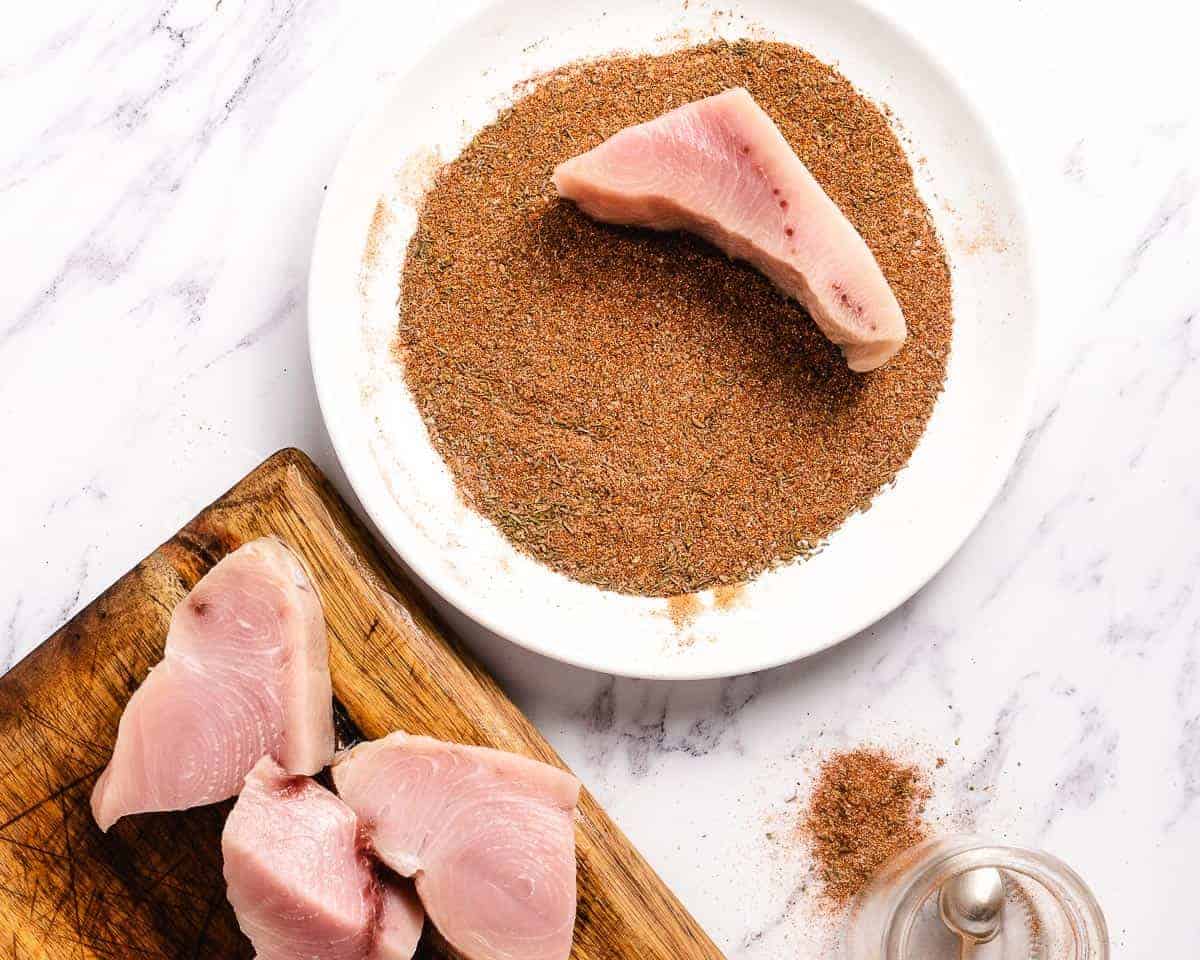
How To Cook Swordfish on The Stove
- To defrost frozen swordfish, place it in the fridge overnight. If you're short on time, put it in a bowl of cold water for about an hour. Change the water every 15 minutes to keep it cold.
- If you have fresh swordfish that still has the bloodline, cut away as shown. Rinse fish under cold running water and pat dry with paper towels.
- Lightly brush the fish with oil or melted butter.
- Press the fish into the blackening seasoning on one side.
The FDA suggests cooking swordfish to an internal temperature of 145 °F (62 °C). The fish should be opaque and flake easily with a fork.
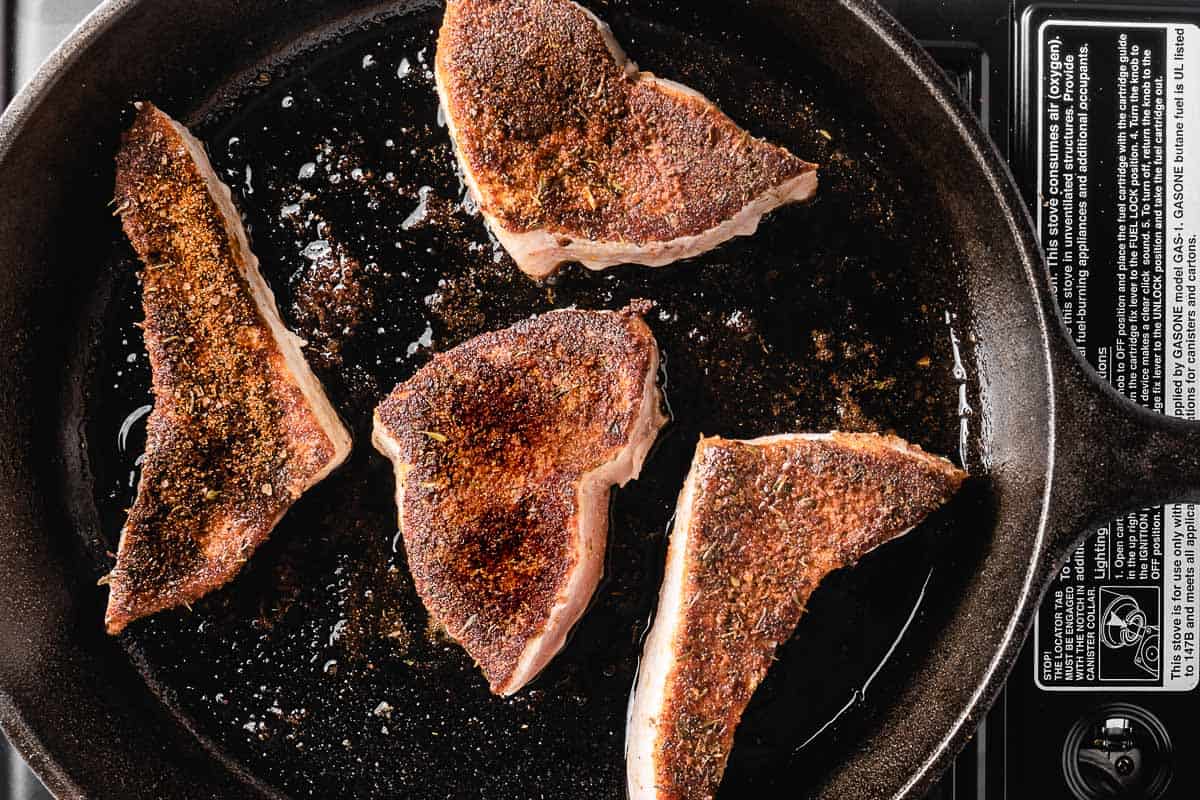
Cooking a Thick Swordfish Steak
If your swordfish is more than 1 ½" thick, start it in a hot skillet, seasoned side down. Sear for 5 minutes, then flip and move the skillet to a 350°F (175°C) oven.
Bake for about 10 minutes, or until the fish is cooked through.
Storage and Reheating
Store the fish in an airtight container in the refrigerator for up to 3 days.
Reheat fish in a small skillet on the stovetop until it's warmed through
What To Serve With Blackened Swordfish
Swordfish goes well with Roasted Vegetables with Garlic, Lemon Asparagus Rice, or Garlic Mashed Potatoes.
For a sweet side with the taste of the tropics, try this Mango with Chili Lime Salt. The sweet mango goes perfectly with the smoky, spicy fish.
FAQ
Swordfish steaks have a mild, slightly sweet flavor with a meaty, firm texture. It is often compared to steak because of its dense texture, making it a popular choice for grilling or searing.
Swordfish is best cooked by grilling, searing, or broiling. It's important not to overcook it, as swordfish can become dry. Aim for an internal temperature of 145°F, and cook it until it's opaque and flakes easily with a fork.
Cook swordfish until it reaches an internal temperature of 145°F. The flesh should become opaque and easily flake with a fork. Be careful not to overcook it, as it can dry out quickly.
Swordfish is not considered very fishy. It has a mild, slightly sweet flavor and a firm, meaty texture, which makes it a good choice for people who don't like strong-tasting fish. Its flavor is often compared to tuna or mahi-mahi.
Where to Cook Your Catch in Key Largo
If you've got some vacation time, you can come on down to The Keys, hop on a charter, and catch your own Florida Keys swordfish.
Take your freshly caught fish to one of our nearby restaurants after a day of fishing. They will cook your fish and serve it with delicious side dishes. It might be the best meal you'll ever eat!
The following restaurants will all Cook Your Catch!

Blackened Swordfish Recipe
Ingredients
MIX THE BLACKENING SEASONING
- 2 tablespoons sweet paprika
- 2 teaspoons onion powder
- 2 teaspoons garlic powder
- ½ teaspoon cayenne pepper use extra to add more heat
- 1 teaspoon dried thyme
- 1 teaspoon dried oregano
- 1 tablespoon salt
- 1 teaspoon ground black pepper
FOR THE FISH
- 1 ½ pounds swordfish steak, defrosted if frozen
- 2 tablespoons olive oil or melted butter
- 2 lemon wedges for serving
Instructions
FOR THE BLACKENING SEASONING
- Whisk together all the spices in a big bowl. Make sure all the spices are blended so there aren't any hot spots.

- Scatter the blackening seasoning on a dinner plate or in a large shallow bowl.
TO PREPARE THE SWORDFISH
- To defrost frozen swordfish, place it in the fridge overnight. If you're short on time, submerge it in a bowl of cold water for about an hour, changing the water every 15 minutes to keep it cold.
- If you have fresh swordfish that still has the bloodline, cut away as shown. Rinse fish under cold running water and pat dry with paper towels.
- Lightly brush the fish with oil or melted butter.
- Press the fish into the blackening seasoning on one side.

TO COOK THE SWORDFISH
- Heat 2 tablespoons of oil over medium-high heat in a 10-inch skillet. Heat for two minutes until hot, but not smoking.
- Place the fish, with the spices face down in the oil, in the hot pan. Sear fish for 3 minutes and then flip to cook the second side. Lower the heat and cook another 3–4 minutes or until an instant-read thermometer reaches 145 °F (62°C)

- Let rest 5 minutes before serving. Serve with lemon wedges

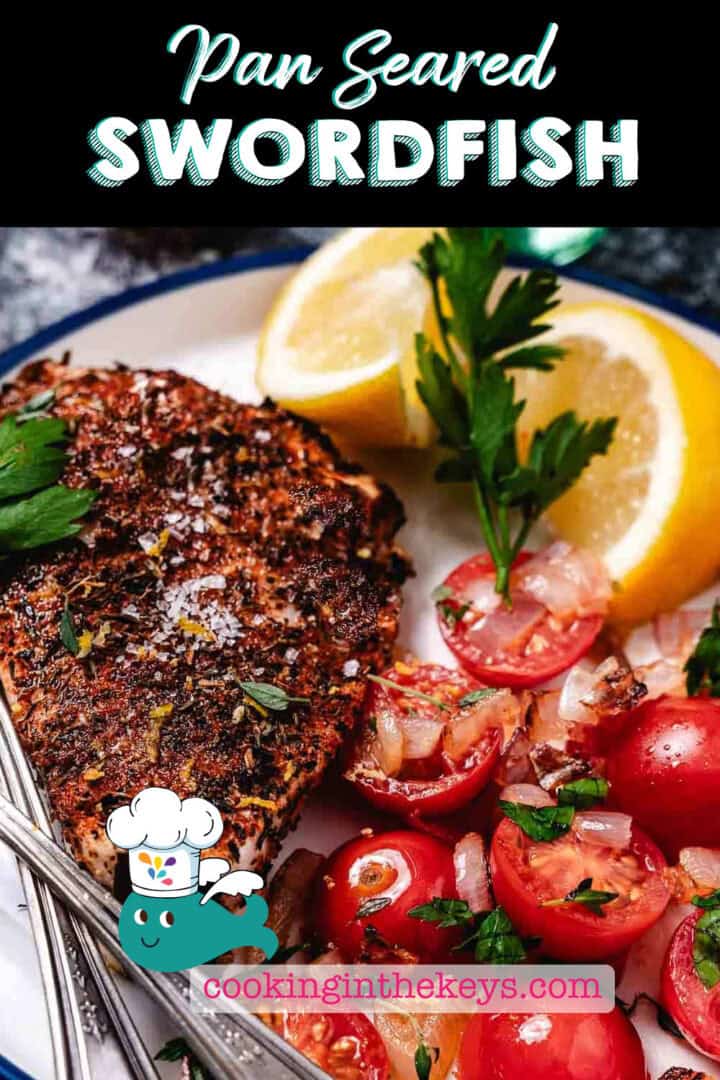
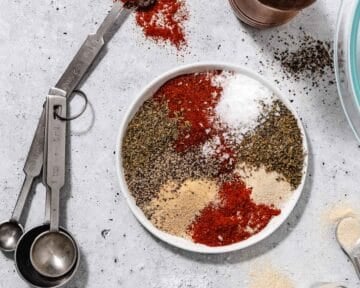
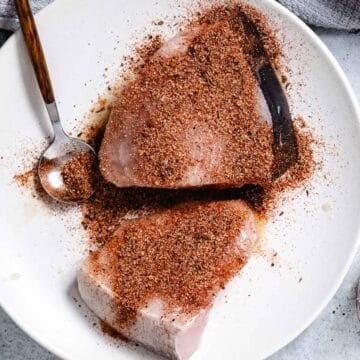
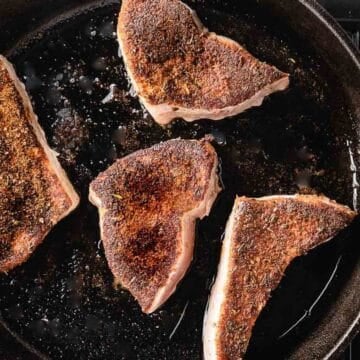
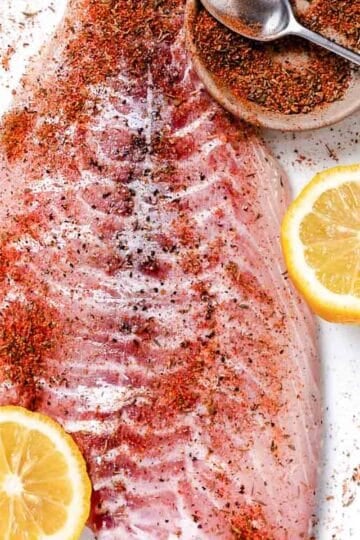
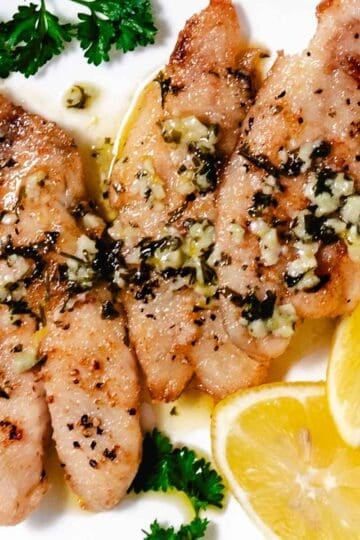


Dalia says
This fish was perfect. I love that its got a little heat, but isn't overpowering. We will be making it all summer. thanks so much.